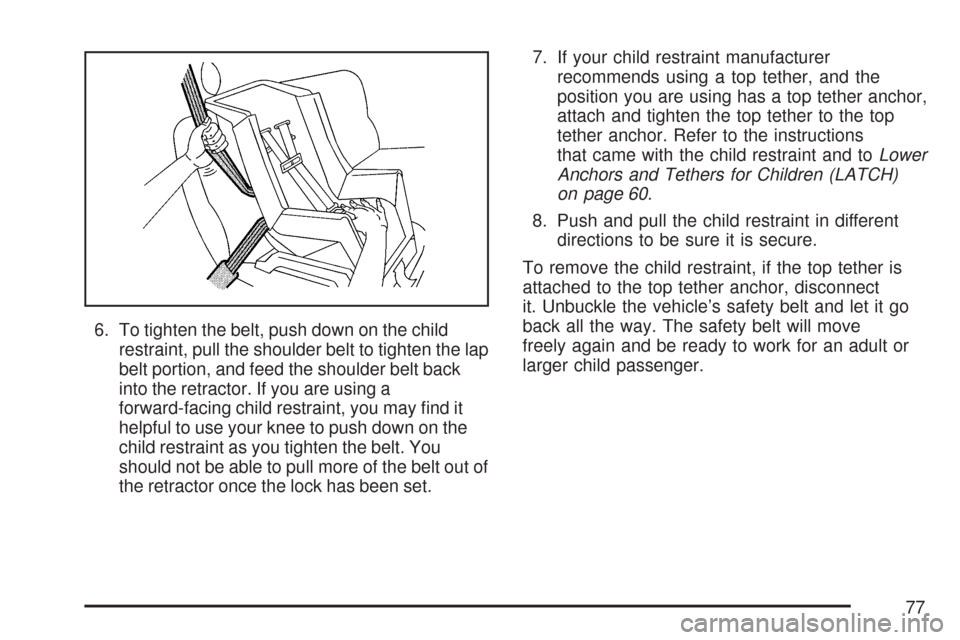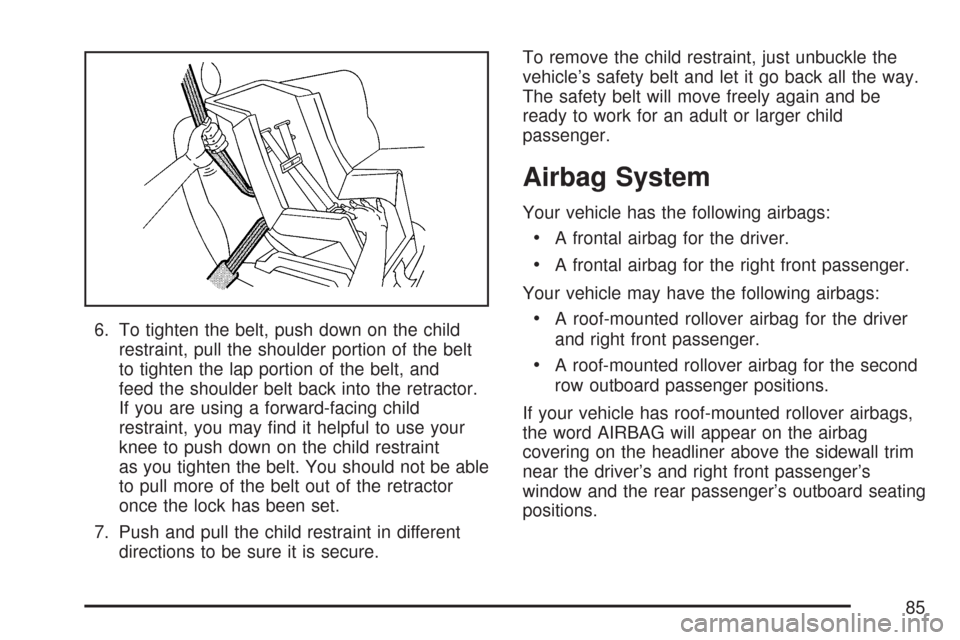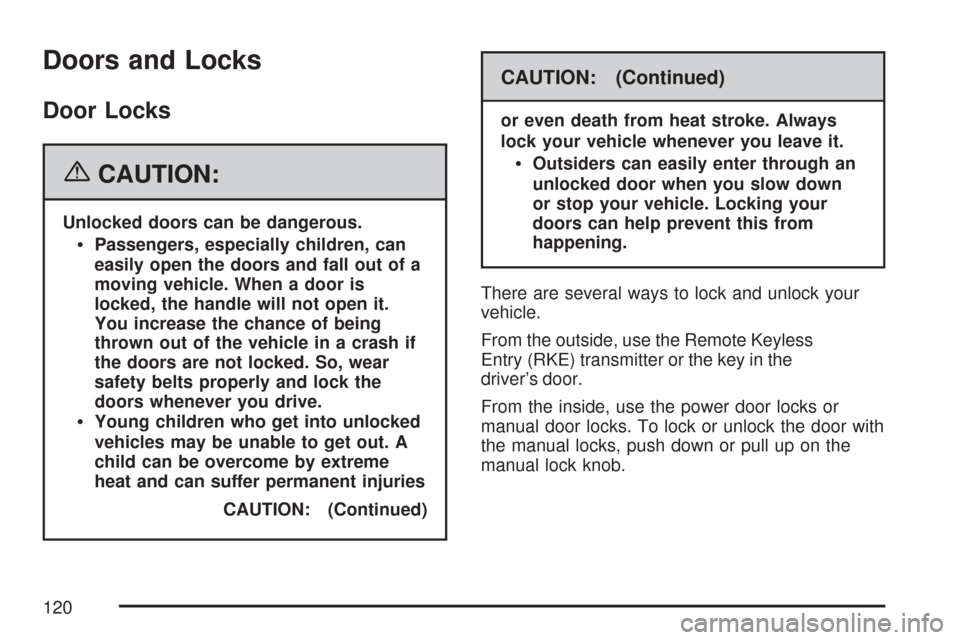Page 1 of 684

Seats and Restraint Systems
....................... 7
Front Seats
.............................................. 9
Rear Seats
............................................. 20
Safety Belts
............................................ 22
Child Restraints
...................................... 46
Airbag System
........................................ 85
Restraint System Check
....................... 106
Features and Controls
.............................. 109
Keys
..................................................... 111
Doors and Locks
.................................. 120
Windows
............................................... 126
Theft-Deterrent Systems
....................... 129
Starting and Operating Your Vehicle
..... 134
Mirrors
.................................................. 171
OnStar
®System
................................... 182
Universal Home Remote System
.......... 186
Storage Areas
...................................... 198
Sunroof
................................................ 202Instrument Panel
....................................... 205
Instrument Panel Overview
................... 208
Climate Controls
................................... 236
Warning Lights, Gages, and
Indicators
.......................................... 248
Driver Information Center (DIC)
............ 269
Audio System(s)
................................... 302
Driving Your Vehicle
................................. 375
Your Driving, the Road, and Your
Vehicle
.............................................. 376
Towing
................................................. 441
Service and Appearance Care
.................. 485
Service
................................................. 488
Fuel
...................................................... 490
Checking Things Under the Hood
......... 498
Rear Axle
............................................. 540
Four-Wheel Drive
.................................. 541
Front Axle
............................................ 543
2007 Chevrolet Silverado Owner ManualM
1
Page 37 of 684

The best way to protect the fetus is to protect the
mother. When a safety belt is worn properly, it
is more likely that the fetus will not be hurt
in a crash. For pregnant women, as for anyone,
the key to making safety belts effective is wearing
them properly.
Right Front Passenger Position
To learn how to wear the right front passenger’s
safety belt properly, seeDriver Position on
page 28.
The right front passenger’s safety belt works the
same way as the driver’s safety belt — except
for one thing. If you ever pull the shoulder portion
of the belt out all the way, you will engage the
child restraint locking feature which may turn off
the passenger’s frontal airbag. If this happens, just
let the belt go back all the way and start again.
Center Front Passenger Position
(Regular Cab)
To learn how to wear the center front passenger’s
safety belt properly, seeDriver Position on
page 28.
The center front passenger’s safety belt works the
same way as the driver’s safety belt — except
for one thing. If you ever pull the shoulder portion
of the belt out all the way, you will engage the
child restraint locking feature. If this happens, just
let the belt go back all the way and start again.
37
Page 65 of 684

{CAUTION:
Each top tether anchor, except the center
top tether anchors in crew and extended
cab models, and lower anchors in the
vehicle are designed to hold only one
child restraint. Attaching more than one
child restraint to a single anchor could
cause the anchor or attachment to come
loose or even break during a crash. A
child or others could be injured if this
happens. To help prevent injury to people
and damage to your vehicle, attach only
one child restraint per anchor.
{CAUTION:
Children can be seriously injured or
strangled if a shoulder belt is wrapped
around their neck and the safety belt
continues to tighten. Secure any unused
safety belts behind the child restraint so
children cannot reach them. Pull the
shoulder belt all the way out of the
retractor to set the lock, if your vehicle
has one, after the child restraint has been
installed. Be sure to follow the
instructions of the child restraint
manufacturer.
Notice:Contact between the child restraint or
the LATCH attachment parts and the vehicle’s
safety belt assembly may cause damage to
these parts. Make sure when securing unused
safety belts behind the child restraint that
there is no contact between the child restraint
or the LATCH attachment parts and the
vehicle’s safety belt assembly.
65
Page 77 of 684

6. To tighten the belt, push down on the child
restraint, pull the shoulder belt to tighten the lap
belt portion, and feed the shoulder belt back
into the retractor. If you are using a
forward-facing child restraint, you may �nd it
helpful to use your knee to push down on the
child restraint as you tighten the belt. You
should not be able to pull more of the belt out of
the retractor once the lock has been set.7. If your child restraint manufacturer
recommends using a top tether, and the
position you are using has a top tether anchor,
attach and tighten the top tether to the top
tether anchor. Refer to the instructions
that came with the child restraint and toLower
Anchors and Tethers for Children (LATCH)
on page 60.
8. Push and pull the child restraint in different
directions to be sure it is secure.
To remove the child restraint, if the top tether is
attached to the top tether anchor, disconnect
it. Unbuckle the vehicle’s safety belt and let it go
back all the way. The safety belt will move
freely again and be ready to work for an adult or
larger child passenger.
77
Page 81 of 684
5. Pull the rest of the shoulder belt all the way
out of the retractor to set the lock.6. To tighten the belt, push down on the child
restraint, pull the shoulder portion of the belt
to tighten the lap portion of the belt, and
feed the shoulder belt back into the retractor.
If you are using a forward-facing child
restraint, you may �nd it helpful to use your
knee to push down on the child restraint
as you tighten the belt. You should not be able
to pull more of the belt from the retractor
once the lock has been set.
81
Page 84 of 684
3. Pick up the latch plate, and run the lap and
shoulder portions of the vehicle’s safety belt
through or around the restraint. The child
restraint instructions will show you how.
4. Buckle the belt. Make sure the release button
is positioned so you would be able to unbuckle
the safety belt quickly if you ever had to.5. Pull the rest of the shoulder belt all the way
out of the retractor to set the lock.
84
Page 85 of 684

6. To tighten the belt, push down on the child
restraint, pull the shoulder portion of the belt
to tighten the lap portion of the belt, and
feed the shoulder belt back into the retractor.
If you are using a forward-facing child
restraint, you may �nd it helpful to use your
knee to push down on the child restraint
as you tighten the belt. You should not be able
to pull more of the belt out of the retractor
once the lock has been set.
7. Push and pull the child restraint in different
directions to be sure it is secure.To remove the child restraint, just unbuckle the
vehicle’s safety belt and let it go back all the way.
The safety belt will move freely again and be
ready to work for an adult or larger child
passenger.
Airbag System
Your vehicle has the following airbags:
A frontal airbag for the driver.
A frontal airbag for the right front passenger.
Your vehicle may have the following airbags:
A roof-mounted rollover airbag for the driver
and right front passenger.
A roof-mounted rollover airbag for the second
row outboard passenger positions.
If your vehicle has roof-mounted rollover airbags,
the word AIRBAG will appear on the airbag
covering on the headliner above the sidewall trim
near the driver’s and right front passenger’s
window and the rear passenger’s outboard seating
positions.
85
Page 120 of 684

Doors and Locks
Door Locks
{CAUTION:
Unlocked doors can be dangerous.
Passengers, especially children, can
easily open the doors and fall out of a
moving vehicle. When a door is
locked, the handle will not open it.
You increase the chance of being
thrown out of the vehicle in a crash if
the doors are not locked. So, wear
safety belts properly and lock the
doors whenever you drive.
Young children who get into unlocked
vehicles may be unable to get out. A
child can be overcome by extreme
heat and can suffer permanent injuries
CAUTION: (Continued)
CAUTION: (Continued)
or even death from heat stroke. Always
lock your vehicle whenever you leave it.
Outsiders can easily enter through an
unlocked door when you slow down
or stop your vehicle. Locking your
doors can help prevent this from
happening.
There are several ways to lock and unlock your
vehicle.
From the outside, use the Remote Keyless
Entry (RKE) transmitter or the key in the
driver’s door.
From the inside, use the power door locks or
manual door locks. To lock or unlock the door with
the manual locks, push down or pull up on the
manual lock knob.
120